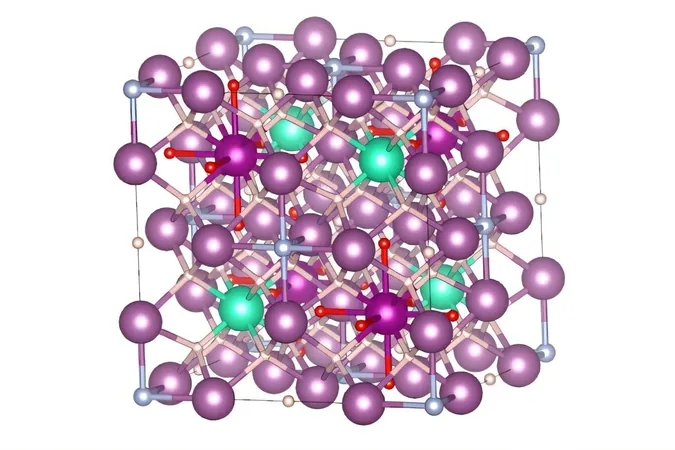
Could Groundbreaking Hydride Designs Unlock Room-Temperature Superconductors?
2024-11-05
Author: Ming
Introduction
In a groundbreaking study from the University of Illinois Chicago, a graduate student may be on the brink of solving one of the most significant challenges facing scientists today: the quest to create superconductors that function at normal temperatures and pressures. This innovation could revolutionize how we use electricity in our everyday lives.
Significance of Superconductors
Superconductors are already pivotal in a variety of essential technologies, from MRI machines to efficient power transmission lines. Currently, however, they need to be cooled to frigid temperatures, which significantly curtails their widespread application. Researchers globally are feverishly pursuing materials that can achieve superconductivity closer to room temperature without the need for extreme cooling techniques.
Innovative Designs for Superconducting Materials
In a recent publication for the Proceedings of the National Academy of Sciences, Adam Denchfield, along with a collaborative team of scientists at UIC, introduced three innovative designs for superconducting materials. Through sophisticated computer simulations, these new designs reveal properties that are essential for achieving superconductivity at remarkably high temperatures.
Key Contributors
Prominent figures in this study include Hyowon Park, an associate professor of physics, and Russell Hemley, a professor of both physics and chemistry, who co-authored the paper with Denchfield, currently a Ph.D. candidate in physics.
The Pursuit of Room-Temperature Superconductivity
For decades, the scientific community has been in pursuit of materials capable of conducting electricity without loss at higher temperatures, specifically room temperature. Achieving this breakthrough would lead to an array of advancements, including improved power grids, enhanced electric motors, and cutting-edge magnetically levitated transport systems.
Controversial Discoveries and Historical Research
In a particularly intriguing twist, a controversial study published in 2023 showcased a superconducting material, which contains the rare earth element lutetium, claiming operational functionality at or near ambient conditions. This prompted skepticism and intrigue in equal measure, pushing Denchfield to investigate historical literature on similar rare earth trihydrides.
"It raised considerable doubts within the scientific community, including myself," Denchfield noted. "Delving into the literature led me to rediscover previous studies from the 1960s that explored unusual behaviors in the electrical conductivity of rare earth trihydrides—a phenomenon still shrouded in mystery today."
Denchfield’s Findings and Research Directions
Denchfield’s research revealed that specific arrangements of lutetium in conjunction with hydrogen and nitrogen could result in remarkable properties, even allowing for high-temperature superconductivity. His findings pointed to a promising lutetium-hydrogen-nitrogen compound, which yielded experimental results akin to superconductivity. Notably, Hemley's research group was spotlighted in major media outlets, including the New York Times.
But Denchfield’s exploratory journey didn’t stop there. He began investigating other potential combos of rare earth hydrides by tinkering with similar elements like yttrium and scandium to potentially enhance superconducting capabilities. This exploration led to the discovery of three cubic structures that could optimize the desired properties through simulations.
Encouraging Future Research
"We’ve introduced three foundational structures of escalating complexity that we encourage others to modify and experiment with," Denchfield highlighted. "This work serves as an inspiration, motivating others to seek out a whole new category of structures that could produce very high-temperature superconductors."
Critical Temperatures and Laboratory Testing
The designs presented in the paper have demonstrated critical temperatures—where superconductive traits emerge—surpassing 200 degrees Kelvin, roughly -100 degrees Fahrenheit. Denchfield emphasizes that some of the suggested designs could eventually lead to the much-coveted "holy grail" of superconductivity, functioning at room temperature and ambient pressure. However, to cement these exciting findings, synthesized materials based on the new designs will require thorough laboratory testing.
Legacy and Future Prospects
As Hemley remarked, "Adam’s study extends the legacy of our group’s previous achievements: from discovering the first near-room-temperature superconductor amidst pressure challenges to compelling evidence of high-temperature superconductivity in lutetium-based materials."
"The thrilling prospects of novel materials with diverse compositions represent an invigorating chapter in our ongoing quest to unearth and innovate materials that could one day transform energy technology as we know it." With continued exploration and experimentation, we may soon unlock the future of lossless power in our everyday lives. Will Denchfield's innovative designs pave the way for the next leap in superconductivity? Only time will tell!




 Brasil (PT)
Brasil (PT)
 Canada (EN)
Canada (EN)
 Chile (ES)
Chile (ES)
 España (ES)
España (ES)
 France (FR)
France (FR)
 Hong Kong (EN)
Hong Kong (EN)
 Italia (IT)
Italia (IT)
 日本 (JA)
日本 (JA)
 Magyarország (HU)
Magyarország (HU)
 Norge (NO)
Norge (NO)
 Polska (PL)
Polska (PL)
 Schweiz (DE)
Schweiz (DE)
 Singapore (EN)
Singapore (EN)
 Sverige (SV)
Sverige (SV)
 Suomi (FI)
Suomi (FI)
 Türkiye (TR)
Türkiye (TR)